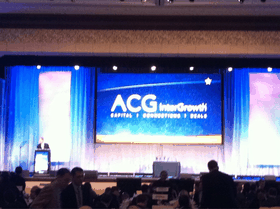
Conferences, Relationships and the Rest of the Year

The ACG InterGrowth Conference in Dallas has been amazing. We’ve heard from Condoleezza Rice and Nolan Ryan. We’ve reconnected with current Axial Members, welcomed new Members, and spent time with friends like Tamika Cody, David Toll and Stephanie McAlaine. Conferences are unparalleled when it comes to facilitating solid in-person connections. We love seeing everyone and establishing friendships that run deeper than just business.
But let’s be honest – we can only maintain so many deep relationships. After the commotion dies down and we pack our bags to go home, we all face a familiar and perennial challenge: how do we leverage these efforts over the next 362 days until next year’s InterGrowth? Here are three ways to make your time at the conference valuable throughout the year:
At the Conference
While conferences are often very social events, many of the people at the event are going to appear similar to you. The fifth time a banker talks to a “generalist private equity firm looking to invest in companies with a proven competitive advantage with at least $3M EBITDA,” it becomes near impossible to remember which card goes with which conversation. The best way to ensure you leave a lasting impression is to focus your conversations on what your firm does differently, even if it doesn’t describe all of what you do. Being remembered for one thing allows you to open the conversation later. Being forgotten results in awkward conversations when you follow up.
As we’ve said many times, specialization leads to better deal flow. Hanson Li from the Hina Group said that sector depth is part of his criteria for deciding whether or not to work with someone. Today at InterGrowth, Rob Newbold spoke about how specialization should bring outsized returns. So take the hint and start thinking about your firm in a more targeted, specialized way. Be remembered, get better returns.
After the Conference
If all you do is attend, you’ve missed the point. When you return home, filter your stack of business cards into first tier, second tier, and third tier piles. Follow up immediately with the first tier pile, those people you can see being really solid contacts, and continue the conversations you started at the conference. The second tier group should be followed up with a week or two later, once you’ve had all of your first tier conversations. Put the third tier conversations into your database for the time in the next year when they become relevant to a deal you’re working on or trying to source.
The Rest of the Year
Your database needs constant maintenance, and over time, data about contacts you meet at conferences inevitably decays. Phone numbers change, colleagues move to new firms, and mandates change. Use local ACG or industry events to stay connected in your region. Take the occasional trip to reconnect with deep connections in other cities and use the phone or email to stay connected.
But sometimes you just can’t keep up with all of the changes. Sometimes your contacts leave the firm before you can get their new contact details or their mandates change without your notification. That’s why LinkedIn and Facebook have become so popular. Unlike databases, in which contacts’ information is static and requires you to update, network data is updated and powered by its own member. Each time someone changes his or her own data, it’s updated instantly for you, in real-time.
The easiest way to avoid losing touch with everyone you meet is to connect with them on LinkedIn or Axial. LinkedIn is great for staying up to date with general business contacts while Axial is tailored more specifically to active deal professionals. Both can help you stay in touch with people you might otherwise forget and, in the case of Axial, can help you discover others who were unable to attend.
If you’re at InterGrowth, we’ll see you tomorrow. Otherwise, we look forward to connecting with you soon.